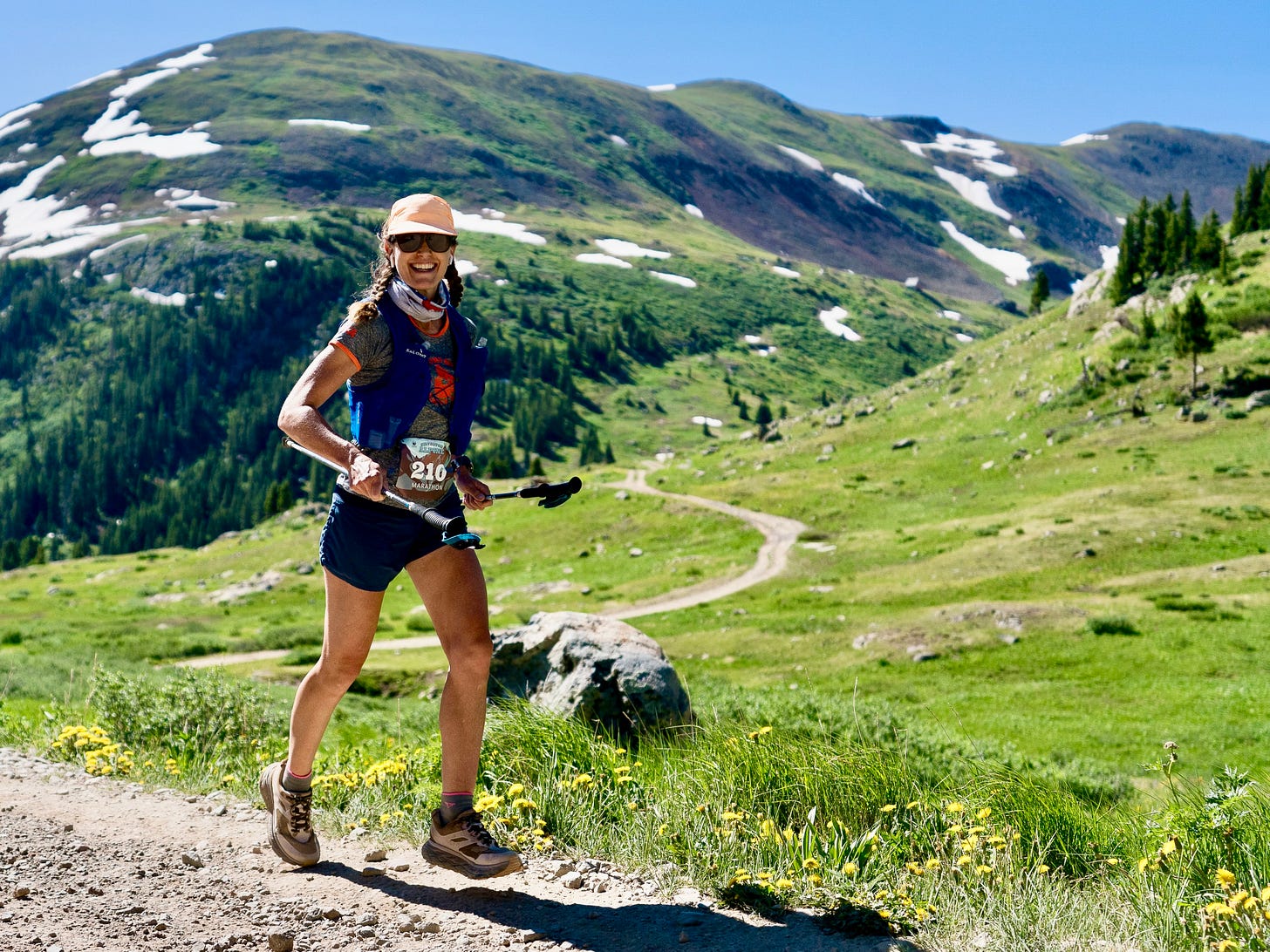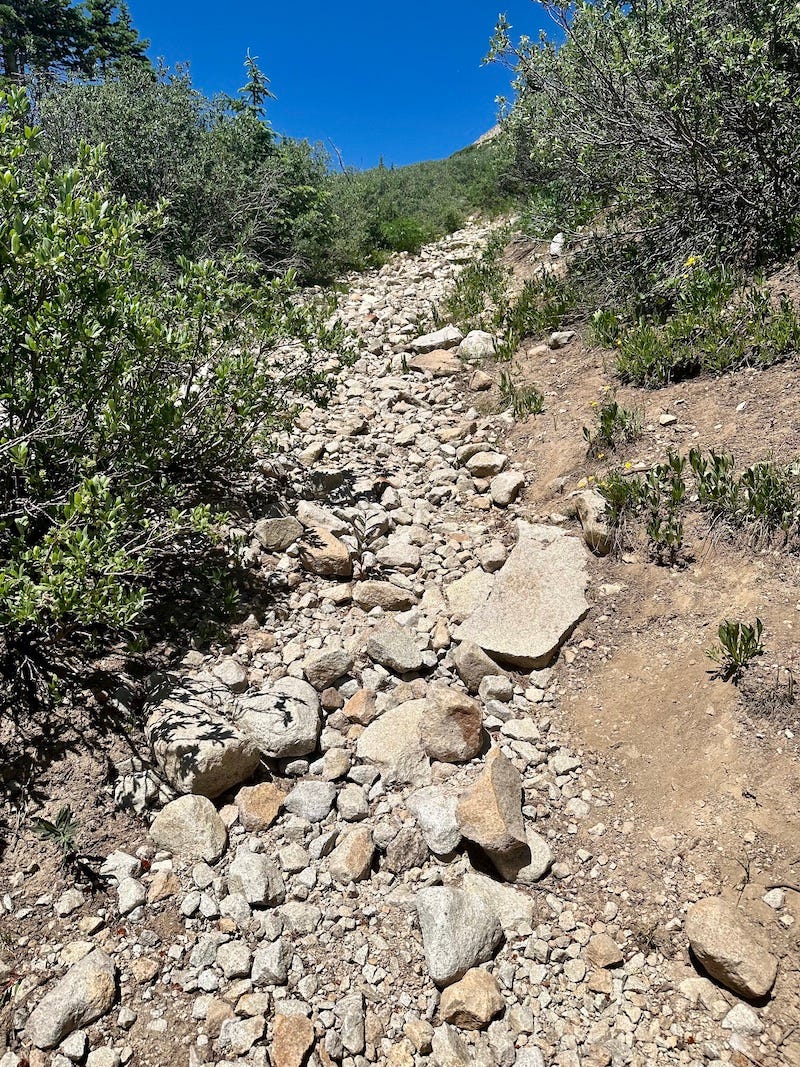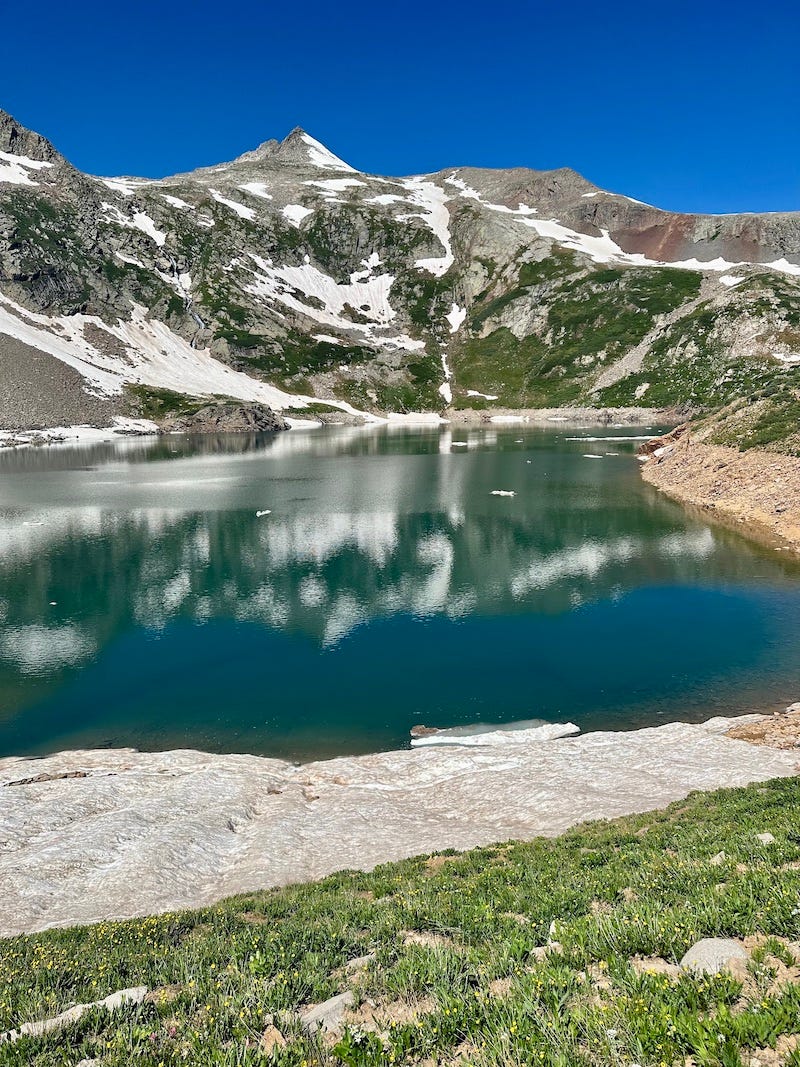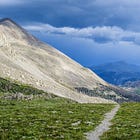Welcome! I’m gratified for an influx of new subscribers. If you’re new here, the second half of this post will give you context on what this newsletter is all about. I hope many of you will drop a note in the comments section introducing yourselves. Let’s hear a bit about your background and what makes you read a newsletter whose tagline is, “Personal essays with practical advice about trail running, mountain life & midlife grit.”
Please consider sharing this newsletter. If you refer it to friends and they subscribe, you can earn a comp’ed paid subscription with bonus posts and an invitation to the monthly online meetup.

I felt a jolt of anxiety and adrenaline when I looked at the calendar and realized only seven full weeks remain until Run Rabbit Run 100 in Steamboat Springs. I’m glad I had that reaction, because it’s proof I care. Unlike some races I sign up for and barely think about until the night before, this race is a biggie. My past six months’ training all aimed toward this one event. I may not have many or any 100s in me left, who knows? I don’t want to blow the opportunity. I want to *finally* run a mountain 100 well.
Although I regularly write about running, I haven’t detailed the structure of my training recently. I decided to share what preparation for a 100-miler looks like in this final phase, when specificity and volume should peak before tapering two to three weeks prior to the race, to arrive at the start line with fresh legs and high energy. Maybe you’re newer to running and curious what goes into preparing for a mountainous 100-miler, or maybe you’re training for one yourself. Perhaps you wonder why anyone would run beyond a 10K. In any case, I hope you find these details helpful or at least interesting.
If you’re not familiar with Run Rabbit Run, it’s a 100-mile race on trails of the Routt National Forest around Steamboat Springs, with approximately 22,000 feet of vertical gain. It can be oppressively hot during the day and freezing cold at night. The high points of the course top out at “only” around 10,500, so I’m not too worried about the altitude, given that my mountain outings around Telluride regularly get above 12,000 feet. I’m more concerned with the technical terrain, temperature swings, and “sleep monsters” that make me sleepy after sunset.
Run Rabbit Run is unique in that it has two divisions—Hare (elite runners going for prize money) and Tortoise (regular runners like me)—and the Hares start four hours later. It can feel both inspiring and discouraging to have the speedy Hares pass on the trail in the early afternoon.
I ran this race once before in 2017 and struggled mightily with sleepiness and breathing (likely exacerbated by that year’s wildfires, which almost caused the race to cancel due to smoke and ash in the air). That was the first 100 where I experienced crazy vivid hallucinations after sunrise on Day 2. I’d round a corner in the forest and see, for example, a log that morphed into an oversized buffalo with a shaggy thick coat of hair on its shoulders. Then the mythical buffalo’s horns would morph into the helmet of a Viking warrior who held a big spear in his hand and said good morning to me. I kid you not, I was exhausted and felt out of my head. But I managed to finish in close to 31 hours.
Why am I putting myself through that again? Well…
Know your “why”
Practically speaking, I need to finish this race to qualify to enter the Hardrock and Western States lotteries—two extra-special 100-milers. Hardrock has been my goal for a decade. I remind myself that if I can’t execute Run Rabbit Run well, then I have no business trying to run Hardrock. After being at Western States again in June to support a friend, I decided I’d like a shot at running States once more in my lifetime.
Digging deeper, I fundamentally crave and relish the drama and challenge of a 24-to-30+ hour journey through the woods. So much can and does happen. So much can go right or wrong. It’s a fascinating experiment in testing the mind and body. Surprises are inevitable, and the outcome is unpredictable, making it an adventure. And, it’s time unplugged—time away from real-life responsibilities, notifications, and worries. All that matters is getting to that finish line as efficiently as possible.
Could I love running as much without a big race on the horizon? Perhaps, but I kind of doubt it. It would be like rehearsing for a stage production for months but never actually putting on the show.
Mostly, I want to prove to myself that I can run a mountain 100 well. It hasn’t happened yet. In all my prior Hardrock-qualifying 100s—Wasatch, Run Rabbit, and High Lonesome x 2—I “fell apart,” meaning I degenerated after nightfall and struggled to finish, failing to meet my time goals. Each took 31 to nearly 36 hours to finish. By contrast, my California 100s resulted in strong sub-24-hour times. I want to prepare well enough and execute smartly enough that I thrive instead of just survive in the event’s second half.
Sometimes I catch myself thinking that this is really privileged, frivolous, and a waste of time. Privileged, yes. But I push back at the other two negative characterizations. You could dismiss a lot of things as “frivolous” or a “waste of time,” such as creating mediocre art or playing amateur golf. But to the artist or golfer, it’s meaningful and part of a greater path toward expression and improvement.
Challenging myself athletically—and treating myself as a legit athlete, in spite of being 54 and in the Tortoise division of this race—brings me joy, drive, and satisfaction. Plenty of projects in my life have qualified as important, selfless, and/or a “have to.” Training for another 100-miler is my thing, and I’m going to prioritize it unapologetically! (And if it’s your thing, you should, too!)
Related: check out the bulleted list toward the end of this post—
Train specifically
A couple of months prior to a 100-miler, I shift my training to be as specific as possible and to mimic the challenges and conditions of the race. That means, for example, I stop running intervals on the town’s relatively flat paved bike path, because the race won’t feature flat pavement, and I won’t need to run that fast in the ultra. Instead, I keep my cardio fitness sharp by fast hiking and jogging as best I can uphill on trails near tree line.


Mostly, peak training involves adapting to greater time-on-feet while moving at a steady tortoise pace, traversing trails similar to the ones in the race. I endeavor to boost my fitness and mental fortitude to the point where long runs feel like less of a big deal, and I finish them feeling as if I could keep going. (Easier said than done.)
I also alter my running times to run when I’m tired and at different times of the day, in order to mimic running through the day (and night) and refueling during the 100. For that reason, I might skip a typical early-morning run and instead challenge myself to head out in the midday sun after eating lunch.
Since early July, I boosted my training in these ways. Last week, I got my volume in terms of both mileage and duration up to where it needs to be—mileage above 60, hours in the mid-teens.
I am not a super high-mileage ultrarunner (as are many who hit 100 miles for the week when training for a 100), because of the need for more recovery at my age and because my pace is significantly slower in the mountains. I’ll grow the volume to the 70s for mileage and hit at least 20 hours for a couple of the upcoming weeks. I also plan to get weekly “vert” (elevation gain) into the 20K’ range.
Below is last week’s training snapshot from TrainingPeaks. I grew my “CTL” or Chronic Training Load, which is a measure of fitness, from the low 100s earlier in the year to where it is now, 164. I managed to run nearly 67 miles with about 16K’ of elevation gain last week. Many of those miles included hiking, because practicing hiking is essential for success at a mountain ultra, and often the terrain is truly un-runnable. If you’re wondering what counts as a “walk” in the grid below, I count my outings as a walk only if I intend to hike the entire time (such as when I’m hiking with my husband and dogs). Otherwise, everything else counts as a “run,” even with a lot of hiking mixed in, if I run at least parts of it.
Also notable: I only had one strength workout last week, totaling 45 minutes. I cut back strength training during peak training to focus more on specific run/hike training and rest.
What I still need to practice and organize
I’m far from ready for the September 15 race. These are some of the things I need to practice:
Efficiency—I’m in a habit of pausing my watch and taking breaks during long runs when I eat or when I adjust clothing layers and get stuff in and out of my pack. Usually, these mini-breaks cause me to lose momentum. It’s fine to pause and enjoy the great outdoors, but I’m at a point in training where I need to stop pausing my watch and start trying to do these tasks more efficiently, while still walking, to get better at maintaining constant forward motion. All the minutes spent pausing during ultras—to take care of stuff along the trail, or to make use of an aid station—quickly add up to hours.
Nighttime and lighting—I got a new headlamp and need to test it out during a couple of nighttime practice runs. More to the point, I need to get stoked and gain confidence about running in the dark. I fear it, because I get so sleepy and it’s harder to see the trail. I’m trying to be optimistic that if I really rest during the taper and store up on sleep the week prior to the race, I’ll be OK. I also gained inspiration from Becky Bates, the 61-year-old ultrarunner who just ran a super strong Hardrock. She told me a couple of days ago how much she loves nighttime running and feels energized by it—she can’t wait for the sun to go down! (I’m writing a story about her for Trail Runner.) Her attitude pumped me up—seize the night! Which gets to the next essential point:
Mental attitude—I need to deliberately think about and visualize how I want to feel and behave during this race. I want to personify positivity like Courtney Dauwalter or Paul Terranova. I want to react to discomfort and problems during the race with humor and grace. I literally will practice saying out loud, “I got this! No problem!”
Nutrition and hydration planning—I need to dial in my plan for eating and drinking during the 100 in a way that prevents bonking, dehydration, and nausea. As detailed in last summer’s High Lonesome 100 suffer-fest report, I developed a gag reflex after sunset in my past three 100s, which progressed to puking last time. I used to be able to eat anything and plenty during ultras. I worked with a sports nutritionist earlier this year to find more palatable foods, to use simple sugar and caffeine more strategically, and to keep fueling after sunset. Now I need to fine-tune it.
Get organized and do my homework—I need to study the course and make a plan for using drop bags and my crew and pacer. Even though I ran this event in 2017, I don’t remember the course well, and parts of the route have changed since then. Thankfully, Olga King is helping me develop a smart pacing plan.
Stay healthy and taper well—I can’t finish the race unless I start it healthy, well rested, and uninjured. Getting enough sleep, eating nutritiously and plenty, avoiding sick people and washing my hands a lot—all of these measures matter. I’m not drinking much these days (just beer in moderation, rarely wine, no hard alcohol), and I’ll fully abstain a couple of weeks prior to the race to enhance my sleep and avoid alcohol’s nutritionally bankrupt calories in favor of optimal nutrition during the taper. My left knee still aches from chondromalacia (cartilage loss), but it’s manageable, and an MRI two weeks ago confirmed it has not worsened significantly. My body’s stiffness and achiness during a long run actually seems a little better, perhaps from starting a low dose of Estradiol (an estrogen patch) as part of menopausal hormone therapy a few months ago.
So, enough about my training. How does an ultrarunning rookie tackle the Run Rabbit Run 100? This short documentary remains one of my all-time favorites, capturing a moving “bromance” against the backdrop of the 2017 Run Rabbit Run. I hope you’ll watch it.
I hope you enjoyed this post. If you’d like more comprehensive advice about how to train for an ultra, I hope you’ll get my book.
Remember the invitation to introduce yourself in the comments below. What’s your big summer project?





Wow that’s crazy about the hallucinations you had. You are an incredible ultra runner & others have learned so much from you sharing these epic experiences!
Great article! I have my second 100 mile “attempt” coming up in 3 days! Ive knocked out a couple of 50k’s and a 100k since my first 100 mile DNF….I used your book a lot through my training👍👍😉